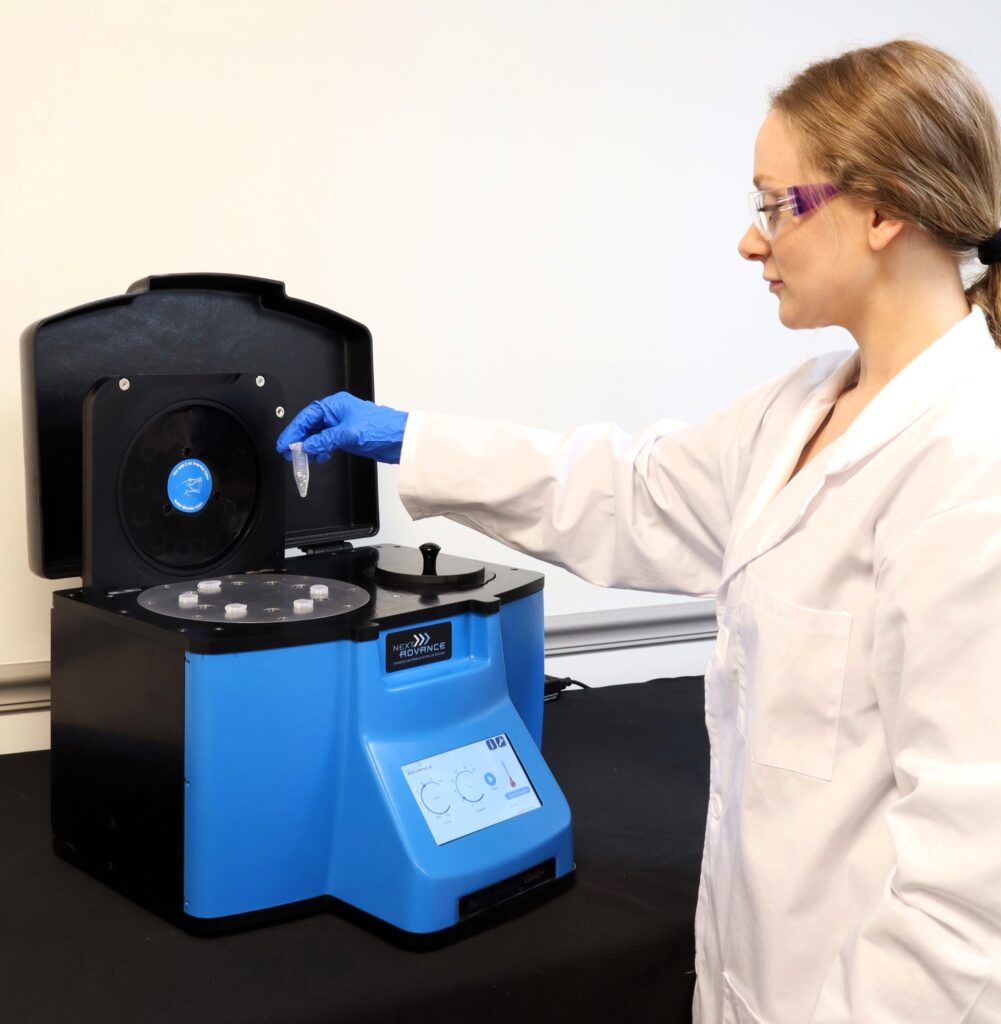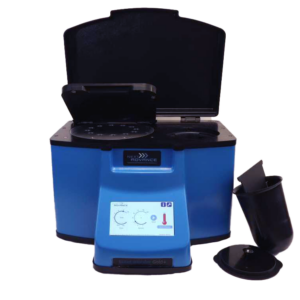Ideal for Placenta Tissue Homogenization
Do you spend lots of time and effort homogenizing placenta tissue samples? The Bullet Blender® tissue homogenizer delivers high quality and superior yields. No other homogenizer comes close to delivering the Bullet Blender’s winning combination of top-quality performance and budget-friendly affordability. See below for a placenta tissue homogenization protocol.
Save Time, Effort and Get Superior Results with
The Bullet Blender Homogenizer
Consistent and High Yield Results
Run up to 24 samples at the same time under microprocessor-controlled conditions, ensuring experimental reproducibility and high yield. Process samples from 10mg or less up to 3.5g.No Cross Contamination
No part of the Bullet Blender ever touches the tissue – the sample tubes are kept closed during homogenization. There are no probes to clean between samples.Samples Stay Cool
The Bullet Blenders’ innovative and elegant design provides convective cooling of the samples, so they do not heat up more than several degrees. In fact, our Gold+ models hold the sample temperature to about 4ºC.Easy and Convenient to Use
Just place beads and buffer along with your tissue sample in standard tubes, load tubes directly in the Bullet Blender, select time and speed, and press start.Risk Free Purchase
Thousands of peer-reviewed journal articles attest to the consistency and quality of the Bullet Blender homogenizer. We offer a 2 year warranty, extendable to 4 years, because our Bullet Blenders are reliable and last for many years.Placenta Tissue Homogenization Protocol
| Sample Tube | Protocol |
|---|---|
| 1.5 mL tubes | 1.5 mL tubes Placenta Protocol |
| 1.5/2 mL tubes in 5 mL adapters | 1.5/2 mL tubes in 5 mL adapters Placenta Protocol |
| 5 mL tubes | 5 mL tubes Placenta Protocol |
What Else Can You Homogenize? Tough or Soft, No Problem!
The Bullet Blender can process a wide range of samples including organ tissue, cell culture, plant tissue, and small organisms. You can homogenize samples as tough as mouse femur or for gentle applications such as tissue dissociation or organelle isolation.

Want more guidance? Need a quote? Contact us:

Bullet Blender Models
Select Publications using the Bullet Blender to Homogenize Placenta Tissue
2474232
placenta
1
apa
50
date
desc
10631
https://www.nextadvance.com/wp-content/plugins/zotpress/
%7B%22status%22%3A%22success%22%2C%22updateneeded%22%3Afalse%2C%22instance%22%3Afalse%2C%22meta%22%3A%7B%22request_last%22%3A0%2C%22request_next%22%3A0%2C%22used_cache%22%3Atrue%7D%2C%22data%22%3A%5B%7B%22key%22%3A%22X7SZ6KU4%22%2C%22library%22%3A%7B%22id%22%3A2474232%7D%2C%22meta%22%3A%7B%22creatorSummary%22%3A%22Rubinchik-Stern%20et%20al.%22%2C%22parsedDate%22%3A%222016-07%22%2C%22numChildren%22%3A2%7D%2C%22bib%22%3A%22%26lt%3Bdiv%20class%3D%26quot%3Bcsl-bib-body%26quot%3B%20style%3D%26quot%3Bline-height%3A%202%3B%20padding-left%3A%201em%3B%20text-indent%3A-1em%3B%26quot%3B%26gt%3B%5Cn%20%20%26lt%3Bdiv%20class%3D%26quot%3Bcsl-entry%26quot%3B%26gt%3BRubinchik-Stern%2C%20M.%2C%20Shmuel%2C%20M.%2C%20Bar%2C%20J.%2C%20Eyal%2C%20S.%2C%20%26amp%3B%20Kovo%2C%20M.%20%282016%29.%20Maternal%26%23x2013%3Bfetal%20transfer%20of%20indocyanine%20green%20across%20the%20perfused%20human%20placenta.%20%26lt%3Bi%26gt%3BReproductive%20Toxicology%26lt%3B%5C%2Fi%26gt%3B%2C%20%26lt%3Bi%26gt%3B62%26lt%3B%5C%2Fi%26gt%3B%2C%20100%26%23x2013%3B105.%20%26lt%3Ba%20class%3D%26%23039%3Bzp-DOIURL%26%23039%3B%20href%3D%26%23039%3Bhttps%3A%5C%2F%5C%2Fdoi.org%5C%2F10.1016%5C%2Fj.reprotox.2016.04.017%26%23039%3B%26gt%3Bhttps%3A%5C%2F%5C%2Fdoi.org%5C%2F10.1016%5C%2Fj.reprotox.2016.04.017%26lt%3B%5C%2Fa%26gt%3B%26lt%3B%5C%2Fdiv%26gt%3B%5Cn%26lt%3B%5C%2Fdiv%26gt%3B%22%2C%22data%22%3A%7B%22itemType%22%3A%22journalArticle%22%2C%22title%22%3A%22Maternal%5Cu2013fetal%20transfer%20of%20indocyanine%20green%20across%20the%20perfused%20human%20placenta%22%2C%22creators%22%3A%5B%7B%22creatorType%22%3A%22author%22%2C%22firstName%22%3A%22Miriam%22%2C%22lastName%22%3A%22Rubinchik-Stern%22%7D%2C%7B%22creatorType%22%3A%22author%22%2C%22firstName%22%3A%22Miriam%22%2C%22lastName%22%3A%22Shmuel%22%7D%2C%7B%22creatorType%22%3A%22author%22%2C%22firstName%22%3A%22Jacob%22%2C%22lastName%22%3A%22Bar%22%7D%2C%7B%22creatorType%22%3A%22author%22%2C%22firstName%22%3A%22Sara%22%2C%22lastName%22%3A%22Eyal%22%7D%2C%7B%22creatorType%22%3A%22author%22%2C%22firstName%22%3A%22Michal%22%2C%22lastName%22%3A%22Kovo%22%7D%5D%2C%22abstractNote%22%3A%22Indocyanine%20green%20%28ICG%29%20is%20an%20FDA-approved%20near-infrared%20imaging%20probe%2C%20given%20also%20to%20pregnant%20women.%20We%20aimed%20to%20characterize%20ICG%26%23039%3Bs%20transplacental%20transfer%20using%20the%20ex-vivo%20perfusion%20model.%20Placentas%20were%20obtained%20from%20caesarean%20deliveries.%20Cotyledons%20were%20cannulated%20and%20dually%20perfused.%20ICG%2C%209.6%20%5Cu03bcg%5C%2FmL%20and%20antipyrine%20%2850%20%5Cu03bcg%5C%2FmL%29%20were%20added%20to%20the%20maternal%20circulation%20in%20the%20absence%20%28n%20%3D%204%29%20or%20the%20presence%20of%20the%20organic%20anion%20transporting%20polypeptide%20%28OATPs%29%20inhibitor%20rifampin%20%2810%20%5Cu03bcg%5C%2FmL%3B%20n%20%3D%205%29%20or%20the%20P-glycoprotein%20inhibitor%20valspodar%20%282%20%5Cu03bcg%5C%2FmL%3B%20n%20%3D%203%29.%20ICG%26%23039%3Bs%20maternal-to-fetal%20transfer%20was%20evaluated%20over%20180%20min.%20The%20cumulative%20percent%20of%20ICG%20in%20the%20fetal%20reservoir%20was%20minor.%20When%20ICG%20transfer%20was%20normalized%20to%20that%20of%20antipyrine%2C%20it%20was%20lower%20in%20the%20presence%20of%20rifampin%20%28a%2041%25%20decrease%3B%20p%20%26lt%3B%200.05%29.%20Valspodar%20did%20not%20appear%20to%20modify%20the%20kinetics%20of%20ICG.%20ICG%26%23039%3Bs%20transplacental%20transfer%20is%20minimal%20and%20is%20probably%20OATP-mediated.%20The%20placenta%20is%20an%20effective%20protective%20barrier%20to%20ICG%26%23039%3Bs%20distribution%20into%20the%20fetus.%22%2C%22date%22%3A%22July%202016%22%2C%22language%22%3A%22%22%2C%22DOI%22%3A%2210.1016%5C%2Fj.reprotox.2016.04.017%22%2C%22ISSN%22%3A%220890-6238%22%2C%22url%22%3A%22http%3A%5C%2F%5C%2Fwww.sciencedirect.com%5C%2Fscience%5C%2Farticle%5C%2Fpii%5C%2FS0890623816300673%22%2C%22collections%22%3A%5B%22M2MNG549%22%5D%2C%22dateModified%22%3A%222016-06-10T18%3A24%3A14Z%22%7D%7D%2C%7B%22key%22%3A%22XDGMGHD3%22%2C%22library%22%3A%7B%22id%22%3A2474232%7D%2C%22meta%22%3A%7B%22creatorSummary%22%3A%22Bonney%20et%20al.%22%2C%22parsedDate%22%3A%222016-07%22%2C%22numChildren%22%3A2%7D%2C%22bib%22%3A%22%26lt%3Bdiv%20class%3D%26quot%3Bcsl-bib-body%26quot%3B%20style%3D%26quot%3Bline-height%3A%202%3B%20padding-left%3A%201em%3B%20text-indent%3A-1em%3B%26quot%3B%26gt%3B%5Cn%20%20%26lt%3Bdiv%20class%3D%26quot%3Bcsl-entry%26quot%3B%26gt%3BBonney%2C%20E.%20A.%2C%20Krebs%2C%20K.%2C%20Saade%2C%20G.%2C%20Kechichian%2C%20T.%2C%20Trivedi%2C%20J.%2C%20Huaizhi%2C%20Y.%2C%20%26amp%3B%20Menon%2C%20R.%20%282016%29.%20Differential%20senescence%20in%20feto-maternal%20tissues%20during%20mouse%20pregnancy.%20%26lt%3Bi%26gt%3BPlacenta%26lt%3B%5C%2Fi%26gt%3B%2C%20%26lt%3Bi%26gt%3B43%26lt%3B%5C%2Fi%26gt%3B%2C%2026%26%23x2013%3B34.%20%26lt%3Ba%20class%3D%26%23039%3Bzp-DOIURL%26%23039%3B%20href%3D%26%23039%3Bhttps%3A%5C%2F%5C%2Fdoi.org%5C%2F10.1016%5C%2Fj.placenta.2016.04.018%26%23039%3B%26gt%3Bhttps%3A%5C%2F%5C%2Fdoi.org%5C%2F10.1016%5C%2Fj.placenta.2016.04.018%26lt%3B%5C%2Fa%26gt%3B%26lt%3B%5C%2Fdiv%26gt%3B%5Cn%26lt%3B%5C%2Fdiv%26gt%3B%22%2C%22data%22%3A%7B%22itemType%22%3A%22journalArticle%22%2C%22title%22%3A%22Differential%20senescence%20in%20feto-maternal%20tissues%20during%20mouse%20pregnancy%22%2C%22creators%22%3A%5B%7B%22creatorType%22%3A%22author%22%2C%22firstName%22%3A%22Elizabeth%20A.%22%2C%22lastName%22%3A%22Bonney%22%7D%2C%7B%22creatorType%22%3A%22author%22%2C%22firstName%22%3A%22Kendall%22%2C%22lastName%22%3A%22Krebs%22%7D%2C%7B%22creatorType%22%3A%22author%22%2C%22firstName%22%3A%22George%22%2C%22lastName%22%3A%22Saade%22%7D%2C%7B%22creatorType%22%3A%22author%22%2C%22firstName%22%3A%22Talar%22%2C%22lastName%22%3A%22Kechichian%22%7D%2C%7B%22creatorType%22%3A%22author%22%2C%22firstName%22%3A%22Jayshil%22%2C%22lastName%22%3A%22Trivedi%22%7D%2C%7B%22creatorType%22%3A%22author%22%2C%22firstName%22%3A%22Yin%22%2C%22lastName%22%3A%22Huaizhi%22%7D%2C%7B%22creatorType%22%3A%22author%22%2C%22firstName%22%3A%22Ramkumar%22%2C%22lastName%22%3A%22Menon%22%7D%5D%2C%22abstractNote%22%3A%22Background%5CnHuman%20studies%20show%20that%20fetal%20membranes%20have%20a%20limited%20lifespan%20and%20undergo%20telomere-dependent%20cellular%20senescence%20that%20is%20augmented%20by%20oxidative%20stress%20and%20mediated%20by%20p38%20mitogen%20activated%20protein%20kinase%20%28MAPK%29.%20Further%2C%20these%20studies%20suggest%20that%20fetal%20membranes%20are%20anatomically%20and%20physiologically%20positioned%20to%20transmit%20senescence%20signals%20that%20may%20initiate%20parturition%20at%20term.%5CnMethods%5CnLongitudinal%20evaluation%20of%20feto-maternal%20tissues%20from%20mouse%20pregnancies%20was%20undertaken%20to%20determine%20the%20molecular%20progression%20of%20senescence%20during%20normal%20pregnancy.%20On%20days%2010%5Cu201318%20of%20gestation%2C%20C57BL%5C%2F6%20mice%20were%20euthanized.%20Fetal%20membranes%2C%20placenta%2C%20and%20decidua%5C%2Futerus%20were%20collected.%20Tissues%20were%20examined%20for%20Telomere%20length%20%28TL%29%20and%20the%20presence%20of%20Phosphorylated%20%28P%29%20p38MAPK%20and%20p53%2C%20p21%20and%20senescence%20associated%20%5Cu03b2-Galactosidase%20%28SA-%20%5Cu03b2-Gal%29.%5CnFindings%5CnLinear%20regression%20modeling%20of%20observed%20telomere%20length%20as%20a%20function%20of%20gestational%20age%20revealed%20that%20beta%20%28%5Cu03b2%29%2C%20the%20slope%20of%20the%20linear%20regression%20was%20negative%20and%20significantly%20different%20from%20zero%20for%20each%20tissue%20%28fetal%20membranes%2C%20%5Cu03b2%5Cu00a0%3D%5Cu00a0%5Cu22120.1901%5Cu00a0%5Cu00b1%5Cu00a00.03125%2C%20p%5Cu00a0%26lt%3B%5Cu00a00.0001%3B%20placenta%20%5Cu03b2%5Cu00a0%3D%5Cu00a0%5Cu22120.09000%5Cu00a0%5Cu00b1%5Cu00a00.03474%2C%20p%5Cu00a0%3D%5Cu00a00.0135%3B%20decidua%5C%2Futerus%20%5Cu03b2%5Cu00a0%3D%5Cu00a0%5Cu22120.1317%5Cu00a0%5Cu00b1%5Cu00a00.03264%2C%20p%5Cu00a0%3D%5Cu00a00.0003%29.%20Progressive%20activation%20p38MAPK%20was%20observed%20in%20all%20tissues%20from%20days%2010%20to%20day18%2C%20with%20the%20highest%20activation%20observed%20in%20fetal%20membranes.%20Activation%20of%20p53%20was%20progressive%20in%20fetal%20membranes.%20In%20contrast%2C%20active%20p53%20was%20constitutive%20in%20placenta%20and%20decidua%5C%2Futerus%20throughout%20gestation.%20Detection%20of%20p21%20indicated%20that%20pro-senescent%20change%20was%20higher%20in%20all%20compartments%20on%20day%2018%20as%20compared%20to%20other%20days.%20The%20number%20of%20SA-%5Cu03b2-Gal%20positive%20cells%20increased%20in%20fetal%20membranes%20as%20gestation%20progressed.%20However%2C%20in%20placenta%20and%20uterus%20and%20decidua%5C%2Futerus%20SA-%5Cu03b2-Gal%20was%20seen%20only%20in%20days%2015%20and%2018.%5CnConclusions%5CnTelomere%20dependent%20p38%20and%20p53%20mediated%20senescence%20progressed%20in%20mouse%20fetal%20membranes%20as%20gestation%20advanced.%20Although%20senescence%20is%20evident%2C%20telomere%20dependent%20events%20were%20not%20dominant%20in%20placenta%20or%20decidua%5C%2Futerus.%20Fetal%20membrane%20senescence%20may%20significantly%20contribute%20to%20mechanisms%20of%20parturition%20at%20term.%22%2C%22date%22%3A%22July%202016%22%2C%22language%22%3A%22%22%2C%22DOI%22%3A%2210.1016%5C%2Fj.placenta.2016.04.018%22%2C%22ISSN%22%3A%220143-4004%22%2C%22url%22%3A%22http%3A%5C%2F%5C%2Fwww.sciencedirect.com%5C%2Fscience%5C%2Farticle%5C%2Fpii%5C%2FS0143400416300789%22%2C%22collections%22%3A%5B%22M2MNG549%22%5D%2C%22dateModified%22%3A%222016-06-10T17%3A50%3A42Z%22%7D%7D%2C%7B%22key%22%3A%222WURGETJ%22%2C%22library%22%3A%7B%22id%22%3A2474232%7D%2C%22meta%22%3A%7B%22creatorSummary%22%3A%22Rosner%20et%20al.%22%2C%22parsedDate%22%3A%222016-03%22%2C%22numChildren%22%3A2%7D%2C%22bib%22%3A%22%26lt%3Bdiv%20class%3D%26quot%3Bcsl-bib-body%26quot%3B%20style%3D%26quot%3Bline-height%3A%202%3B%20padding-left%3A%201em%3B%20text-indent%3A-1em%3B%26quot%3B%26gt%3B%5Cn%20%20%26lt%3Bdiv%20class%3D%26quot%3Bcsl-entry%26quot%3B%26gt%3BRosner%2C%20J.%20Y.%2C%20Gupta%2C%20M.%2C%20McGill%2C%20M.%2C%20Xue%2C%20X.%2C%20Chatterjee%2C%20P.%20K.%2C%20Yoshida-Hay%2C%20M.%2C%20Robeson%2C%20W.%2C%20%26amp%3B%20Metz%2C%20C.%20N.%20%282016%29.%20Magnesium%20deficiency%20during%20pregnancy%20in%20mice%20impairs%20placental%20size%20and%20function.%20%26lt%3Bi%26gt%3BPlacenta%26lt%3B%5C%2Fi%26gt%3B%2C%20%26lt%3Bi%26gt%3B39%26lt%3B%5C%2Fi%26gt%3B%2C%2087%26%23x2013%3B93.%20%26lt%3Ba%20class%3D%26%23039%3Bzp-DOIURL%26%23039%3B%20href%3D%26%23039%3Bhttps%3A%5C%2F%5C%2Fdoi.org%5C%2F10.1016%5C%2Fj.placenta.2016.01.009%26%23039%3B%26gt%3Bhttps%3A%5C%2F%5C%2Fdoi.org%5C%2F10.1016%5C%2Fj.placenta.2016.01.009%26lt%3B%5C%2Fa%26gt%3B%26lt%3B%5C%2Fdiv%26gt%3B%5Cn%26lt%3B%5C%2Fdiv%26gt%3B%22%2C%22data%22%3A%7B%22itemType%22%3A%22journalArticle%22%2C%22title%22%3A%22Magnesium%20deficiency%20during%20pregnancy%20in%20mice%20impairs%20placental%20size%20and%20function%22%2C%22creators%22%3A%5B%7B%22creatorType%22%3A%22author%22%2C%22firstName%22%3A%22J.%20Y.%22%2C%22lastName%22%3A%22Rosner%22%7D%2C%7B%22creatorType%22%3A%22author%22%2C%22firstName%22%3A%22M.%22%2C%22lastName%22%3A%22Gupta%22%7D%2C%7B%22creatorType%22%3A%22author%22%2C%22firstName%22%3A%22M.%22%2C%22lastName%22%3A%22McGill%22%7D%2C%7B%22creatorType%22%3A%22author%22%2C%22firstName%22%3A%22X.%22%2C%22lastName%22%3A%22Xue%22%7D%2C%7B%22creatorType%22%3A%22author%22%2C%22firstName%22%3A%22P.%20K.%22%2C%22lastName%22%3A%22Chatterjee%22%7D%2C%7B%22creatorType%22%3A%22author%22%2C%22firstName%22%3A%22M.%22%2C%22lastName%22%3A%22Yoshida-Hay%22%7D%2C%7B%22creatorType%22%3A%22author%22%2C%22firstName%22%3A%22W.%22%2C%22lastName%22%3A%22Robeson%22%7D%2C%7B%22creatorType%22%3A%22author%22%2C%22firstName%22%3A%22C.%20N.%22%2C%22lastName%22%3A%22Metz%22%7D%5D%2C%22abstractNote%22%3A%22Objective%5CnMaternal%20magnesium%20%28Mg%29%20deficiency%20has%20been%20associated%20with%20fetal%20growth%20restriction.%20Using%20a%20mouse%20model%20of%20maternal%20Mg%20deficiency-induced%20fetal%20growth%20restriction%2C%20we%20sought%20to%20investigate%20the%20effect%20of%20Mg%20deficiency%20on%20placental%20physiology%20and%20function.%5CnMethods%5CnIn%5Cu00a0vivo%3A%20Pregnant%20Swiss%20Webster%20mice%20were%20fed%20either%20100%25%20of%20the%20recommended%20amount%20of%20Mg%20%28control%29%20or%2010%25Mg%20%28Mg-deficient%29%20%288%20per%20group%29.%20Dams%20were%20euthanized%20on%20gestational%20day%2017%20and%20placentas%20were%20collected%2C%20weighed%20and%20assessed%20for%20Mg%20concentrations%2C%20as%20well%20as%20nutrient%20transporter%20mRNA%20expression.%20For%20nutrient%20transfer%20studies%2C%20control%20and%20Mg-deficient%20dams%20%286%20per%20group%29%20were%20injected%20with%2014C-amino%20acids%20and%203H-glucose%20and%20trans-placental%20passage%20was%20determined.%20In%5Cu00a0vitro%3A%20BeWo%20placental%20cells%20were%20grown%20in%20media%20containing%2010%25Mg%20to%20100%25Mg%20and%20the%20effects%20of%20Mg%20status%20on%20cell%20proliferation%2C%20oxidative%20stress%20and%20nutrient%20uptake%20were%20measured.%20Data%20were%20analyzed%20by%20Student%26%23039%3Bs%20t-tests%20comparing%20controls%20vs.%20Mg-deficient%20animals%20or%20cells.%20For%20multiple%20comparisons%2C%20data%20were%20analyzed%20by%20ANOVA%20followed%20by%20Dunnett%26%23039%3Bs%20post%20hoc%20testing.%5CnResults%5CnIn%5Cu00a0vivo%3A%20Maternal%20Mg%20deficiency%20decreased%20placental%20Mg%20content%2C%20placental%20and%20fetal%20weights%2C%20ratio%20of%20fetal%3Aplacental%20weight%20%28P%5Cu00a0%26lt%3B%5Cu00a00.05%29%2C%20placental%20Slc7a5%20transporter%20mRNA%20expression%20and%20transplacental%20nutrient%20transport%20%28P%5Cu00a0%26lt%3B%5Cu00a00.05%29.%20In%5Cu00a0vitro%3A%20Mg%20deficiency%20reduced%20BeWo%20nutrient%20uptake%20%28P%5Cu00a0%26lt%3B%5Cu00a00.01%29%20and%20cell%20proliferation%20%28P%5Cu00a0%26lt%3B%5Cu00a00.01%29%2C%20and%20increased%20oxidative%20stress%20%28P%5Cu00a0%26lt%3B%5Cu00a00.01%29.%5CnConclusion%5CnThese%20findings%20highlight%20the%20adverse%20effects%20of%20maternal%20Mg%20deficiency%20on%20fetal%20weight%20and%20placental%20function%2C%20including%20transport%20and%20proliferation%20and%20may%20explain%20the%20fetal%20growth%20restriction%20observed%20with%20moderate%20Mg%20deficiency%20in%20mice.%22%2C%22date%22%3A%22March%202016%22%2C%22language%22%3A%22%22%2C%22DOI%22%3A%2210.1016%5C%2Fj.placenta.2016.01.009%22%2C%22ISSN%22%3A%220143-4004%22%2C%22url%22%3A%22http%3A%5C%2F%5C%2Fwww.sciencedirect.com%5C%2Fscience%5C%2Farticle%5C%2Fpii%5C%2FS0143400416300091%22%2C%22collections%22%3A%5B%22M2MNG549%22%5D%2C%22dateModified%22%3A%222016-06-24T15%3A44%3A25Z%22%7D%7D%2C%7B%22key%22%3A%22F2AHDSWN%22%2C%22library%22%3A%7B%22id%22%3A2474232%7D%2C%22meta%22%3A%7B%22creatorSummary%22%3A%22Saad%20et%20al.%22%2C%22parsedDate%22%3A%222014-01-01%22%2C%22numChildren%22%3A0%7D%2C%22bib%22%3A%22%26lt%3Bdiv%20class%3D%26quot%3Bcsl-bib-body%26quot%3B%20style%3D%26quot%3Bline-height%3A%202%3B%20padding-left%3A%201em%3B%20text-indent%3A-1em%3B%26quot%3B%26gt%3B%5Cn%20%20%26lt%3Bdiv%20class%3D%26quot%3Bcsl-entry%26quot%3B%26gt%3BSaad%2C%20A.%20F.%2C%20Kechichian%2C%20T.%2C%20Yin%2C%20H.%2C%20Sbrana%2C%20E.%2C%20Longo%2C%20M.%2C%20Wen%2C%20M.%2C%20Tamayo%2C%20E.%2C%20Hankins%2C%20G.%20D.%20V.%2C%20Saade%2C%20G.%20R.%2C%20%26amp%3B%20Costantine%2C%20M.%20M.%20%282014%29.%20Effects%20of%20Pravastatin%20on%20Angiogenic%20and%20Placental%20Hypoxic%20Imbalance%20in%20a%20Mouse%20Model%20of%20Preeclampsia.%20%26lt%3Bi%26gt%3BReproductive%20Sciences%26lt%3B%5C%2Fi%26gt%3B%2C%20%26lt%3Bi%26gt%3B21%26lt%3B%5C%2Fi%26gt%3B%281%29%2C%20138%26%23x2013%3B145.%20%26lt%3Ba%20class%3D%26%23039%3Bzp-DOIURL%26%23039%3B%20href%3D%26%23039%3Bhttps%3A%5C%2F%5C%2Fdoi.org%5C%2F10.1177%5C%2F1933719113492207%26%23039%3B%26gt%3Bhttps%3A%5C%2F%5C%2Fdoi.org%5C%2F10.1177%5C%2F1933719113492207%26lt%3B%5C%2Fa%26gt%3B%26lt%3B%5C%2Fdiv%26gt%3B%5Cn%26lt%3B%5C%2Fdiv%26gt%3B%22%2C%22data%22%3A%7B%22itemType%22%3A%22journalArticle%22%2C%22title%22%3A%22Effects%20of%20Pravastatin%20on%20Angiogenic%20and%20Placental%20Hypoxic%20Imbalance%20in%20a%20Mouse%20Model%20of%20Preeclampsia%22%2C%22creators%22%3A%5B%7B%22creatorType%22%3A%22author%22%2C%22firstName%22%3A%22A.%20F.%22%2C%22lastName%22%3A%22Saad%22%7D%2C%7B%22creatorType%22%3A%22author%22%2C%22firstName%22%3A%22T.%22%2C%22lastName%22%3A%22Kechichian%22%7D%2C%7B%22creatorType%22%3A%22author%22%2C%22firstName%22%3A%22H.%22%2C%22lastName%22%3A%22Yin%22%7D%2C%7B%22creatorType%22%3A%22author%22%2C%22firstName%22%3A%22E.%22%2C%22lastName%22%3A%22Sbrana%22%7D%2C%7B%22creatorType%22%3A%22author%22%2C%22firstName%22%3A%22M.%22%2C%22lastName%22%3A%22Longo%22%7D%2C%7B%22creatorType%22%3A%22author%22%2C%22firstName%22%3A%22M.%22%2C%22lastName%22%3A%22Wen%22%7D%2C%7B%22creatorType%22%3A%22author%22%2C%22firstName%22%3A%22E.%22%2C%22lastName%22%3A%22Tamayo%22%7D%2C%7B%22creatorType%22%3A%22author%22%2C%22firstName%22%3A%22G.%20D.%20V.%22%2C%22lastName%22%3A%22Hankins%22%7D%2C%7B%22creatorType%22%3A%22author%22%2C%22firstName%22%3A%22G.%20R.%22%2C%22lastName%22%3A%22Saade%22%7D%2C%7B%22creatorType%22%3A%22author%22%2C%22firstName%22%3A%22M.%20M.%22%2C%22lastName%22%3A%22Costantine%22%7D%5D%2C%22abstractNote%22%3A%22%22%2C%22date%22%3A%222014-01-01%22%2C%22language%22%3A%22en%22%2C%22DOI%22%3A%2210.1177%5C%2F1933719113492207%22%2C%22ISSN%22%3A%221933-7191%2C%201933-7205%22%2C%22url%22%3A%22http%3A%5C%2F%5C%2Frsx.sagepub.com%5C%2Fcgi%5C%2Fdoi%5C%2F10.1177%5C%2F1933719113492207%22%2C%22collections%22%3A%5B%22M2MNG549%22%5D%2C%22dateModified%22%3A%222015-07-20T13%3A52%3A20Z%22%7D%7D%2C%7B%22key%22%3A%22EF9ZQF6J%22%2C%22library%22%3A%7B%22id%22%3A2474232%7D%2C%22meta%22%3A%7B%22creatorSummary%22%3A%22Quach%20et%20al.%22%2C%22parsedDate%22%3A%222014%22%2C%22numChildren%22%3A0%7D%2C%22bib%22%3A%22%26lt%3Bdiv%20class%3D%26quot%3Bcsl-bib-body%26quot%3B%20style%3D%26quot%3Bline-height%3A%202%3B%20padding-left%3A%201em%3B%20text-indent%3A-1em%3B%26quot%3B%26gt%3B%5Cn%20%20%26lt%3Bdiv%20class%3D%26quot%3Bcsl-entry%26quot%3B%26gt%3BQuach%2C%20K.%2C%20Grover%2C%20S.%20A.%2C%20Kenigsberg%2C%20S.%2C%20%26amp%3B%20Librach%2C%20C.%20L.%20%282014%29.%20A%20combination%20of%20single%20nucleotide%20polymorphisms%20in%20the%203%26%23x2032%3Buntranslated%20region%20of%20HLA-G%20is%20associated%20with%20preeclampsia.%20%26lt%3Bi%26gt%3BHuman%20Immunology%26lt%3B%5C%2Fi%26gt%3B%2C%20%26lt%3Bi%26gt%3B75%26lt%3B%5C%2Fi%26gt%3B%2812%29%2C%201163%26%23x2013%3B1170.%20%26lt%3Ba%20class%3D%26%23039%3Bzp-DOIURL%26%23039%3B%20href%3D%26%23039%3Bhttps%3A%5C%2F%5C%2Fdoi.org%5C%2F10.1016%5C%2Fj.humimm.2014.10.009%26%23039%3B%26gt%3Bhttps%3A%5C%2F%5C%2Fdoi.org%5C%2F10.1016%5C%2Fj.humimm.2014.10.009%26lt%3B%5C%2Fa%26gt%3B%26lt%3B%5C%2Fdiv%26gt%3B%5Cn%26lt%3B%5C%2Fdiv%26gt%3B%22%2C%22data%22%3A%7B%22itemType%22%3A%22journalArticle%22%2C%22title%22%3A%22A%20combination%20of%20single%20nucleotide%20polymorphisms%20in%20the%203%5Cu2032untranslated%20region%20of%20HLA-G%20is%20associated%20with%20preeclampsia%22%2C%22creators%22%3A%5B%7B%22creatorType%22%3A%22author%22%2C%22firstName%22%3A%22K.%22%2C%22lastName%22%3A%22Quach%22%7D%2C%7B%22creatorType%22%3A%22author%22%2C%22firstName%22%3A%22S.A.%22%2C%22lastName%22%3A%22Grover%22%7D%2C%7B%22creatorType%22%3A%22author%22%2C%22firstName%22%3A%22S.%22%2C%22lastName%22%3A%22Kenigsberg%22%7D%2C%7B%22creatorType%22%3A%22author%22%2C%22firstName%22%3A%22C.L.%22%2C%22lastName%22%3A%22Librach%22%7D%5D%2C%22abstractNote%22%3A%22%22%2C%22date%22%3A%2212%5C%2F2014%22%2C%22language%22%3A%22en%22%2C%22DOI%22%3A%2210.1016%5C%2Fj.humimm.2014.10.009%22%2C%22ISSN%22%3A%2201988859%22%2C%22url%22%3A%22http%3A%5C%2F%5C%2Flinkinghub.elsevier.com%5C%2Fretrieve%5C%2Fpii%5C%2FS0198885914004741%22%2C%22collections%22%3A%5B%22M2MNG549%22%5D%2C%22dateModified%22%3A%222015-10-30T20%3A21%3A51Z%22%7D%7D%2C%7B%22key%22%3A%22JEENPXD3%22%2C%22library%22%3A%7B%22id%22%3A2474232%7D%2C%22meta%22%3A%7B%22creatorSummary%22%3A%22Hill%20et%20al.%22%2C%22parsedDate%22%3A%222014%22%2C%22numChildren%22%3A0%7D%2C%22bib%22%3A%22%26lt%3Bdiv%20class%3D%26quot%3Bcsl-bib-body%26quot%3B%20style%3D%26quot%3Bline-height%3A%202%3B%20padding-left%3A%201em%3B%20text-indent%3A-1em%3B%26quot%3B%26gt%3B%5Cn%20%20%26lt%3Bdiv%20class%3D%26quot%3Bcsl-entry%26quot%3B%26gt%3BHill%2C%20A.%20J.%2C%20Drever%2C%20N.%2C%20Yin%2C%20H.%2C%20Tamayo%2C%20E.%2C%20Saade%2C%20G.%2C%20%26amp%3B%20Bytautiene%2C%20E.%20%282014%29.%20The%20role%20of%20NADPH%20oxidase%20in%20a%20mouse%20model%20of%20fetal%20alcohol%20syndrome.%20%26lt%3Bi%26gt%3BAmerican%20Journal%20of%20Obstetrics%20and%20Gynecology%26lt%3B%5C%2Fi%26gt%3B%2C%20%26lt%3Bi%26gt%3B210%26lt%3B%5C%2Fi%26gt%3B%285%29%2C%20466.e1-466.e5.%20%26lt%3Ba%20class%3D%26%23039%3Bzp-DOIURL%26%23039%3B%20href%3D%26%23039%3Bhttps%3A%5C%2F%5C%2Fdoi.org%5C%2F10.1016%5C%2Fj.ajog.2013.12.019%26%23039%3B%26gt%3Bhttps%3A%5C%2F%5C%2Fdoi.org%5C%2F10.1016%5C%2Fj.ajog.2013.12.019%26lt%3B%5C%2Fa%26gt%3B%26lt%3B%5C%2Fdiv%26gt%3B%5Cn%26lt%3B%5C%2Fdiv%26gt%3B%22%2C%22data%22%3A%7B%22itemType%22%3A%22journalArticle%22%2C%22title%22%3A%22The%20role%20of%20NADPH%20oxidase%20in%20a%20mouse%20model%20of%20fetal%20alcohol%20syndrome%22%2C%22creators%22%3A%5B%7B%22creatorType%22%3A%22author%22%2C%22firstName%22%3A%22Alexandria%20J.%22%2C%22lastName%22%3A%22Hill%22%7D%2C%7B%22creatorType%22%3A%22author%22%2C%22firstName%22%3A%22Nathan%22%2C%22lastName%22%3A%22Drever%22%7D%2C%7B%22creatorType%22%3A%22author%22%2C%22firstName%22%3A%22Huaizhi%22%2C%22lastName%22%3A%22Yin%22%7D%2C%7B%22creatorType%22%3A%22author%22%2C%22firstName%22%3A%22Esther%22%2C%22lastName%22%3A%22Tamayo%22%7D%2C%7B%22creatorType%22%3A%22author%22%2C%22firstName%22%3A%22George%22%2C%22lastName%22%3A%22Saade%22%7D%2C%7B%22creatorType%22%3A%22author%22%2C%22firstName%22%3A%22Egle%22%2C%22lastName%22%3A%22Bytautiene%22%7D%5D%2C%22abstractNote%22%3A%22%22%2C%22date%22%3A%2205%5C%2F2014%22%2C%22language%22%3A%22en%22%2C%22DOI%22%3A%2210.1016%5C%2Fj.ajog.2013.12.019%22%2C%22ISSN%22%3A%2200029378%22%2C%22url%22%3A%22http%3A%5C%2F%5C%2Flinkinghub.elsevier.com%5C%2Fretrieve%5C%2Fpii%5C%2FS0002937813022084%22%2C%22collections%22%3A%5B%22M2MNG549%22%5D%2C%22dateModified%22%3A%222015-08-12T17%3A15%3A09Z%22%7D%7D%2C%7B%22key%22%3A%22PQZN3538%22%2C%22library%22%3A%7B%22id%22%3A2474232%7D%2C%22meta%22%3A%7B%22creatorSummary%22%3A%22Poulsen%20et%20al.%22%2C%22parsedDate%22%3A%222013%22%2C%22numChildren%22%3A0%7D%2C%22bib%22%3A%22%26lt%3Bdiv%20class%3D%26quot%3Bcsl-bib-body%26quot%3B%20style%3D%26quot%3Bline-height%3A%202%3B%20padding-left%3A%201em%3B%20text-indent%3A-1em%3B%26quot%3B%26gt%3B%5Cn%20%20%26lt%3Bdiv%20class%3D%26quot%3Bcsl-entry%26quot%3B%26gt%3BPoulsen%2C%20K.%20P.%2C%20Faith%2C%20N.%20G.%2C%20Steinberg%2C%20H.%2C%20%26amp%3B%20Czuprynski%2C%20C.%20J.%20%282013%29.%20Bacterial%20load%20and%20inflammation%20in%20fetal%20tissues%20is%20not%20dependent%20on%20IL-17a%20or%20IL-22%20in%2010%26%23x2013%3B14%20day%20pregnant%20mice%20infected%20with%20Listeria%20monocytogenes.%20%26lt%3Bi%26gt%3BMicrobial%20Pathogenesis%26lt%3B%5C%2Fi%26gt%3B%2C%20%26lt%3Bi%26gt%3B56%26lt%3B%5C%2Fi%26gt%3B%2C%2047%26%23x2013%3B52.%20%26lt%3Ba%20class%3D%26%23039%3Bzp-DOIURL%26%23039%3B%20href%3D%26%23039%3Bhttps%3A%5C%2F%5C%2Fdoi.org%5C%2F10.1016%5C%2Fj.micpath.2012.11.003%26%23039%3B%26gt%3Bhttps%3A%5C%2F%5C%2Fdoi.org%5C%2F10.1016%5C%2Fj.micpath.2012.11.003%26lt%3B%5C%2Fa%26gt%3B%26lt%3B%5C%2Fdiv%26gt%3B%5Cn%26lt%3B%5C%2Fdiv%26gt%3B%22%2C%22data%22%3A%7B%22itemType%22%3A%22journalArticle%22%2C%22title%22%3A%22Bacterial%20load%20and%20inflammation%20in%20fetal%20tissues%20is%20not%20dependent%20on%20IL-17a%20or%20IL-22%20in%2010%5Cu201314%20day%20pregnant%20mice%20infected%20with%20Listeria%20monocytogenes%22%2C%22creators%22%3A%5B%7B%22creatorType%22%3A%22author%22%2C%22firstName%22%3A%22Keith%20P.%22%2C%22lastName%22%3A%22Poulsen%22%7D%2C%7B%22creatorType%22%3A%22author%22%2C%22firstName%22%3A%22Nancy%20G.%22%2C%22lastName%22%3A%22Faith%22%7D%2C%7B%22creatorType%22%3A%22author%22%2C%22firstName%22%3A%22Howard%22%2C%22lastName%22%3A%22Steinberg%22%7D%2C%7B%22creatorType%22%3A%22author%22%2C%22firstName%22%3A%22Charles%20J.%22%2C%22lastName%22%3A%22Czuprynski%22%7D%5D%2C%22abstractNote%22%3A%22%22%2C%22date%22%3A%223%5C%2F2013%22%2C%22language%22%3A%22en%22%2C%22DOI%22%3A%2210.1016%5C%2Fj.micpath.2012.11.003%22%2C%22ISSN%22%3A%2208824010%22%2C%22url%22%3A%22http%3A%5C%2F%5C%2Flinkinghub.elsevier.com%5C%2Fretrieve%5C%2Fpii%5C%2FS0882401012001957%22%2C%22collections%22%3A%5B%22M2MNG549%22%5D%2C%22dateModified%22%3A%222015-07-22T14%3A05%3A51Z%22%7D%7D%2C%7B%22key%22%3A%22TC522EIT%22%2C%22library%22%3A%7B%22id%22%3A2474232%7D%2C%22meta%22%3A%7B%22creatorSummary%22%3A%22Drever%20et%20al.%22%2C%22parsedDate%22%3A%222012%22%2C%22numChildren%22%3A0%7D%2C%22bib%22%3A%22%26lt%3Bdiv%20class%3D%26quot%3Bcsl-bib-body%26quot%3B%20style%3D%26quot%3Bline-height%3A%202%3B%20padding-left%3A%201em%3B%20text-indent%3A-1em%3B%26quot%3B%26gt%3B%5Cn%20%20%26lt%3Bdiv%20class%3D%26quot%3Bcsl-entry%26quot%3B%26gt%3BDrever%2C%20N.%2C%20Yin%2C%20H.%2C%20Kechichian%2C%20T.%2C%20Costantine%2C%20M.%2C%20Longo%2C%20M.%2C%20Saade%2C%20G.%20R.%2C%20%26amp%3B%20Bytautiene%2C%20E.%20%282012%29.%20The%20expression%20of%20antioxidant%20enzymes%20in%20a%20mouse%20model%20of%20fetal%20alcohol%20syndrome.%20%26lt%3Bi%26gt%3BAmerican%20Journal%20of%20Obstetrics%20and%20Gynecology%26lt%3B%5C%2Fi%26gt%3B%2C%20%26lt%3Bi%26gt%3B206%26lt%3B%5C%2Fi%26gt%3B%284%29%2C%20358.e19-358.e22.%20%26lt%3Ba%20class%3D%26%23039%3Bzp-DOIURL%26%23039%3B%20href%3D%26%23039%3Bhttps%3A%5C%2F%5C%2Fdoi.org%5C%2F10.1016%5C%2Fj.ajog.2012.01.017%26%23039%3B%26gt%3Bhttps%3A%5C%2F%5C%2Fdoi.org%5C%2F10.1016%5C%2Fj.ajog.2012.01.017%26lt%3B%5C%2Fa%26gt%3B%26lt%3B%5C%2Fdiv%26gt%3B%5Cn%26lt%3B%5C%2Fdiv%26gt%3B%22%2C%22data%22%3A%7B%22itemType%22%3A%22journalArticle%22%2C%22title%22%3A%22The%20expression%20of%20antioxidant%20enzymes%20in%20a%20mouse%20model%20of%20fetal%20alcohol%20syndrome%22%2C%22creators%22%3A%5B%7B%22creatorType%22%3A%22author%22%2C%22firstName%22%3A%22Nathan%22%2C%22lastName%22%3A%22Drever%22%7D%2C%7B%22creatorType%22%3A%22author%22%2C%22firstName%22%3A%22Huaizhi%22%2C%22lastName%22%3A%22Yin%22%7D%2C%7B%22creatorType%22%3A%22author%22%2C%22firstName%22%3A%22Talar%22%2C%22lastName%22%3A%22Kechichian%22%7D%2C%7B%22creatorType%22%3A%22author%22%2C%22firstName%22%3A%22Maged%22%2C%22lastName%22%3A%22Costantine%22%7D%2C%7B%22creatorType%22%3A%22author%22%2C%22firstName%22%3A%22Monica%22%2C%22lastName%22%3A%22Longo%22%7D%2C%7B%22creatorType%22%3A%22author%22%2C%22firstName%22%3A%22George%20R.%22%2C%22lastName%22%3A%22Saade%22%7D%2C%7B%22creatorType%22%3A%22author%22%2C%22firstName%22%3A%22Egle%22%2C%22lastName%22%3A%22Bytautiene%22%7D%5D%2C%22abstractNote%22%3A%22%22%2C%22date%22%3A%2204%5C%2F2012%22%2C%22language%22%3A%22en%22%2C%22DOI%22%3A%2210.1016%5C%2Fj.ajog.2012.01.017%22%2C%22ISSN%22%3A%2200029378%22%2C%22url%22%3A%22http%3A%5C%2F%5C%2Flinkinghub.elsevier.com%5C%2Fretrieve%5C%2Fpii%5C%2FS0002937812000294%22%2C%22collections%22%3A%5B%22M2MNG549%22%5D%2C%22dateModified%22%3A%222015-07-20T16%3A25%3A50Z%22%7D%7D%2C%7B%22key%22%3A%22XU7BJARD%22%2C%22library%22%3A%7B%22id%22%3A2474232%7D%2C%22meta%22%3A%7B%22creatorSummary%22%3A%22Vincent%20et%20al.%22%2C%22numChildren%22%3A2%7D%2C%22bib%22%3A%22%26lt%3Bdiv%20class%3D%26quot%3Bcsl-bib-body%26quot%3B%20style%3D%26quot%3Bline-height%3A%202%3B%20padding-left%3A%201em%3B%20text-indent%3A-1em%3B%26quot%3B%26gt%3B%5Cn%20%20%26lt%3Bdiv%20class%3D%26quot%3Bcsl-entry%26quot%3B%26gt%3BVincent%2C%20R.%20N.%2C%20Gooding%2C%20L.%20D.%2C%20Louie%2C%20K.%2C%20Chan%20Wong%2C%20E.%2C%20%26amp%3B%20Ma%2C%20S.%20%28n.d.%29.%20Altered%20DNA%20methylation%20and%20expression%20of%20PLAGL1%20in%20cord%20blood%20from%20assisted%20reproductive%20technology%20pregnancies%20compared%20with%20natural%20conceptions.%20%26lt%3Bi%26gt%3BFertility%20and%20Sterility%26lt%3B%5C%2Fi%26gt%3B.%20%26lt%3Ba%20class%3D%26%23039%3Bzp-DOIURL%26%23039%3B%20href%3D%26%23039%3Bhttps%3A%5C%2F%5C%2Fdoi.org%5C%2F10.1016%5C%2Fj.fertnstert.2016.04.036%26%23039%3B%26gt%3Bhttps%3A%5C%2F%5C%2Fdoi.org%5C%2F10.1016%5C%2Fj.fertnstert.2016.04.036%26lt%3B%5C%2Fa%26gt%3B%26lt%3B%5C%2Fdiv%26gt%3B%5Cn%26lt%3B%5C%2Fdiv%26gt%3B%22%2C%22data%22%3A%7B%22itemType%22%3A%22journalArticle%22%2C%22title%22%3A%22Altered%20DNA%20methylation%20and%20expression%20of%20PLAGL1%20in%20cord%20blood%20from%20assisted%20reproductive%20technology%20pregnancies%20compared%20with%20natural%20conceptions%22%2C%22creators%22%3A%5B%7B%22creatorType%22%3A%22author%22%2C%22firstName%22%3A%22Rebecca%20N.%22%2C%22lastName%22%3A%22Vincent%22%7D%2C%7B%22creatorType%22%3A%22author%22%2C%22firstName%22%3A%22Luke%20D.%22%2C%22lastName%22%3A%22Gooding%22%7D%2C%7B%22creatorType%22%3A%22author%22%2C%22firstName%22%3A%22Kenny%22%2C%22lastName%22%3A%22Louie%22%7D%2C%7B%22creatorType%22%3A%22author%22%2C%22firstName%22%3A%22Edgar%22%2C%22lastName%22%3A%22Chan%20Wong%22%7D%2C%7B%22creatorType%22%3A%22author%22%2C%22firstName%22%3A%22Sai%22%2C%22lastName%22%3A%22Ma%22%7D%5D%2C%22abstractNote%22%3A%22Objective%5CnTo%20investigate%20DNA%20methylation%20and%20expression%20of%20imprinted%20genes%20and%20an%20imprinted%20gene%20network%20%28IGN%29%20in%20neonates%20conceived%20via%20assisted%20reproductive%20technology%20%28ART%29.%5CnDesign%5CnCase%20control.%5CnSetting%5CnResearch%20institution.%5CnPatient%28s%29%5CnTwo%20hundred%20sixty-four%20cases%20of%20cord%20blood%20and%5C%2For%20placental%20villi%20from%20neonates%20%28101%20IVF%2C%2081%20ICSI%2C%2082%20naturally%20conceived%29.%5CnIntervention%28s%29%5CnPlacentas%20were%20obtained%20at%20birth%20for%20biopsy%20and%20cord%20blood%20extraction.%5CnMain%20Outcome%20Measure%28s%29%5CnDNA%20methylation%20and%20expression%20of%20imprinted%20genes.%5CnResult%28s%29%5CnDNA%20methylation%20at%20the%20PLAGL1%20differentially%20methylated%20region%20%28DMR%29%20was%20significantly%20higher%20in%20IVF%20cord%20blood%20%2848.0%25%29%20compared%20with%20controls%20%2846.0%25%29.%20No%20differences%20were%20found%20in%20DNA%20methylation%20between%20conception%20modes%20for%20KvDMR1%20and%20LINE-1%20in%20cord%20blood%20and%20placenta%20as%20well%20as%20PLAGL1%20and%20PEG10%20in%20placenta%20villi.%20PLAGL1%20expression%20was%20lower%20in%20both%20IVF%20and%20ICSI%20cord%20blood%20groups%20than%20in%20controls%20%28relative%20quantification%20of%200.65%2C%200.74%2C%200.89%2C%20respectively%29.%20Analyzing%20the%20expression%20of%203%20genes%20in%20a%20PLAGL1%20regulated%20IGN%20revealed%20different%20expression%20between%20conception%20modes%20and%20a%20significant%20correlation%20to%20PLAGL1%20expression%20in%20only%20one%20%28KCNQ1OT1%29.%5CnConclusion%28s%29%5CnOur%20results%20suggest%20a%20stability%20of%20DNA%20methylation%20at%20imprinted%20DMRs%3B%20however%2C%20we%20show%20PLAGL1%20methylation%5C%2Fexpression%20to%20be%20altered%20after%20ART.%20As%20PLAGL1%20expression%20correlated%20with%20only%20one%20of%20the%20three%20IGN%20genes%20in%20cord%20blood%2C%20we%20propose%20there%20is%20a%20more%20complex%20mechanism%20of%20regulating%20the%20IGN%20that%20may%20involve%20other%20genes%20and%20epigenetic%20modifications%20in%20this%20tissue.%20Further%20research%20investigating%20IGN-implicated%20genes%20in%20various%20neonatal%20tissues%20is%20warranted%20to%20elucidate%20the%20full%20effects%20ART-induced%20alterations%20to%20PLAGL1%20and%20the%20IGN%20may%20have%20on%20fetal%20growth%5C%2Fdevelopment.%22%2C%22date%22%3A%22%22%2C%22language%22%3A%22%22%2C%22DOI%22%3A%2210.1016%5C%2Fj.fertnstert.2016.04.036%22%2C%22ISSN%22%3A%220015-0282%22%2C%22url%22%3A%22http%3A%5C%2F%5C%2Fwww.sciencedirect.com%5C%2Fscience%5C%2Farticle%5C%2Fpii%5C%2FS0015028216611330%22%2C%22collections%22%3A%5B%22M2MNG549%22%5D%2C%22dateModified%22%3A%222016-06-10T18%3A38%3A08Z%22%7D%7D%5D%7D
Rubinchik-Stern, M., Shmuel, M., Bar, J., Eyal, S., & Kovo, M. (2016). Maternal–fetal transfer of indocyanine green across the perfused human placenta. Reproductive Toxicology, 62, 100–105. https://doi.org/10.1016/j.reprotox.2016.04.017
Bonney, E. A., Krebs, K., Saade, G., Kechichian, T., Trivedi, J., Huaizhi, Y., & Menon, R. (2016). Differential senescence in feto-maternal tissues during mouse pregnancy. Placenta, 43, 26–34. https://doi.org/10.1016/j.placenta.2016.04.018
Rosner, J. Y., Gupta, M., McGill, M., Xue, X., Chatterjee, P. K., Yoshida-Hay, M., Robeson, W., & Metz, C. N. (2016). Magnesium deficiency during pregnancy in mice impairs placental size and function. Placenta, 39, 87–93. https://doi.org/10.1016/j.placenta.2016.01.009
Saad, A. F., Kechichian, T., Yin, H., Sbrana, E., Longo, M., Wen, M., Tamayo, E., Hankins, G. D. V., Saade, G. R., & Costantine, M. M. (2014). Effects of Pravastatin on Angiogenic and Placental Hypoxic Imbalance in a Mouse Model of Preeclampsia. Reproductive Sciences, 21(1), 138–145. https://doi.org/10.1177/1933719113492207
Quach, K., Grover, S. A., Kenigsberg, S., & Librach, C. L. (2014). A combination of single nucleotide polymorphisms in the 3′untranslated region of HLA-G is associated with preeclampsia. Human Immunology, 75(12), 1163–1170. https://doi.org/10.1016/j.humimm.2014.10.009
Hill, A. J., Drever, N., Yin, H., Tamayo, E., Saade, G., & Bytautiene, E. (2014). The role of NADPH oxidase in a mouse model of fetal alcohol syndrome. American Journal of Obstetrics and Gynecology, 210(5), 466.e1-466.e5. https://doi.org/10.1016/j.ajog.2013.12.019
Poulsen, K. P., Faith, N. G., Steinberg, H., & Czuprynski, C. J. (2013). Bacterial load and inflammation in fetal tissues is not dependent on IL-17a or IL-22 in 10–14 day pregnant mice infected with Listeria monocytogenes. Microbial Pathogenesis, 56, 47–52. https://doi.org/10.1016/j.micpath.2012.11.003
Drever, N., Yin, H., Kechichian, T., Costantine, M., Longo, M., Saade, G. R., & Bytautiene, E. (2012). The expression of antioxidant enzymes in a mouse model of fetal alcohol syndrome. American Journal of Obstetrics and Gynecology, 206(4), 358.e19-358.e22. https://doi.org/10.1016/j.ajog.2012.01.017
Vincent, R. N., Gooding, L. D., Louie, K., Chan Wong, E., & Ma, S. (n.d.). Altered DNA methylation and expression of PLAGL1 in cord blood from assisted reproductive technology pregnancies compared with natural conceptions. Fertility and Sterility. https://doi.org/10.1016/j.fertnstert.2016.04.036






